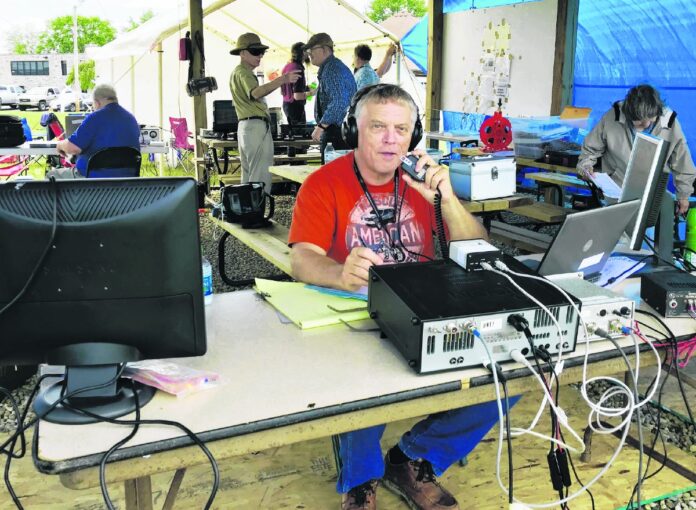GREENFIELD — They’re ready for the day when Hancock County, state or national officials need their assistance to contact each other should the normal ways of communications ever go down.
The Hancock Amateur Radio Club participated in the 24-hour national Field Day exercise this past weekend. The local group set up shop in a field behind St. Michael’s Catholic Church, 515 Jefferson Blvd, from 2 p.m. Saturday through 2 p.m. Sunday.
For over 100 years, amateur radio, sometimes called ham radio, has allowed people from all over and from various walks of life to experiment with electronics and communications techniques, Jon Reeves, club president said.
[sc:text-divider text-divider-title=”Story continues below gallery” ]Click here to purchase photos from this gallery
The clubs provide a free public service to communities during a disaster, all without needing a cell phone or the Internet. The goal of the club is to make sure communications are up and running should a catastrophic event ever strike.
The Field Day exercise was a great time for the local club’s members to come together, test their gear and compete for points against other clubs.
“The day is always a success,” Reeves said.
Throughout the year the club works with the Hancock County Emergency Management Agency, as well as the National Weather Service, to serve as severe weather spotters and to report local storm metrics to the services in order for them to make more accurate judgment calls on storm predictions and patterns.
During the 24-hour Field Day exercise, under the pretense of a simulated emergency situation, the local club conducted this year’s annual training event along with other amateur radio groups throughout the United States and Canada. Over 35,000 people from thousands of locations participated in Field Day in 2016, organizers said.
Field Day gives ham radio operators the ability to work reliably under any conditions from almost any location and create an independent communications network, Greg Chaney, club member, said.
“You never know when you’re going to need this type of communication network,” Chaney said.
This past weekend, club members set up a tent to house their radio gear, several 40 feet antennas, and went about communicating with other amateur radio operators from all over. They also had one operator, Larry Card, Greenfield, working Morse code, earning two points for every communication connection.
The club generated their own off-grid power, via generators, and exchanged information with as many stations throughout the country as possible, earning points along the way.
“This same protocol would be used to launch emergency communications needed by our community should the need ever arise,” Reeves said.
Since the 1930’s, amateur radio operators across North America have established temporary ham radio stations in public locations during the Field Day exercise to showcase the science, skill and the importance of amateur radio operators.
“It’s all about emergency preparedness,” Jim Snellenberger, club member, said.
The event was open to the public and several community members stopped by, including several children who are learning what ham radio is all about.
Simon Padgett, Greenfield, is a club member who brought his young children to the event and let them try to make contact with other operators during the Field Day exercise.
“They were pretty excited when they actually got somebody,” Padgett said.
Anyone may become a licensed amateur radio operator. There are over 725,000 licensed ham operators in the United States. For more information on the local club contact Reeves at [email protected].





